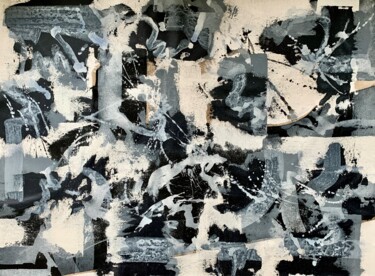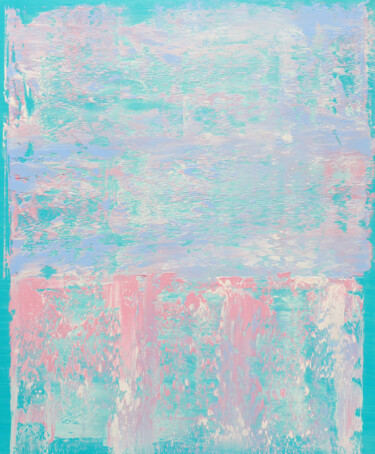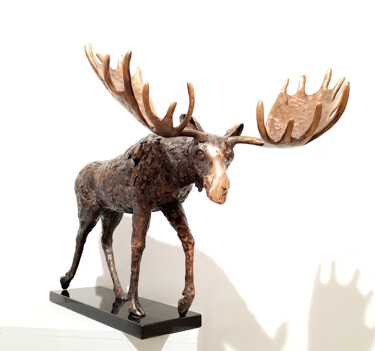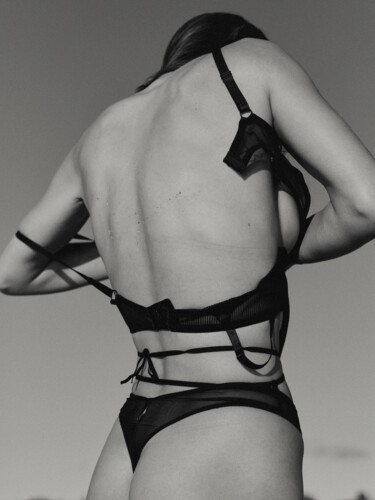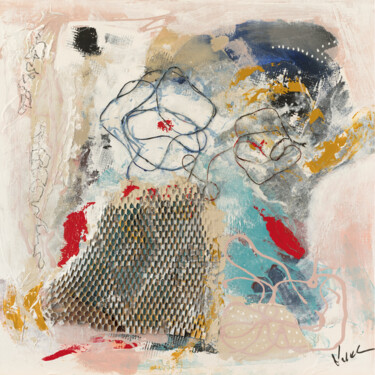 UNFORGETTABLE YOU (2024)Painting by Chantal Proulx
UNFORGETTABLE YOU (2024)Painting by Chantal Proulx
In the vast universe of art, the presence of women has traversed a tortuous and deeply evolutionary path. Historically, women have often been excluded from dominant artistic circles, relegating their contributions to marginal roles or confining them to anonymity. Only in recent centuries, through relentless struggles for emancipation and recognition, have female artists begun to claim their deserved space in the art world.
The transition from obscurity to affirmation has been a challenging journey, marked by socio-cultural barriers that have prevented women from freely expressing their talent. Academic restrictions and limited access to patrons, once exclusively male prerogatives, were significant obstacles that slowed the rise of women in the art world. However, starting from the 20th century, the contributions of women have begun to be more widely recognized, thanks in part to the emergence of women's rights movements, which have promoted greater gender equity.
Today, thanks to platforms like Artmajeur, we witness an increasingly balanced and diverse representation, where female artists masterfully operate in every artistic medium. Painting, sculpture, photography, drawing, collage, textile art, and digital art are just some of the fields in which women have made and continue to make an indelible mark.
In these very fields, the artists on Artmajeur represent an exceptional range of talents, exploring and transforming various media, demonstrating how art can be a powerful tool of expression and change. With each work, they challenge traditional perceptions and expand the horizons of what is possible, confirming the crucial role of women in continuously defining and renewing the contemporary art landscape.
We are now ready to explore the female perspective through different media, analyzing and comparing the works of painters, sculptors, photographers, and other artists on Artmajeur. Ready, set, go!
Three Painters Who Are Rewriting Art
Starting with painting, we have examined the unique approaches to creativity of three exceptional artists, each with a distinctive vision. This same analysis will be extended to sculpture and photography, where we will explore diverse artistic expressions through the works of other talented creators. For the other disciplines—drawing, collage, textile art, and digital art—we will select one representative for each, highlighting their unique impact.
 MIRRORING (2023)Painting by Agnese Kurzemniece
MIRRORING (2023)Painting by Agnese Kurzemniece
 WHEN YOUR HEAD IS IN THE CLOUDS (2023)Painting by Agnes Kurzemniece
WHEN YOUR HEAD IS IN THE CLOUDS (2023)Painting by Agnes Kurzemniece
The painting of Agnese Kurzemniece, an artist who lives and works in Riga (Latvia), deeply explores the theme of femininity within a changing, "expressionist," and surreal environment, through an intensely personal, almost symbolic lens. Initially trained at the Janis Rozentāls Riga Art High School and later refined in painting and graphics at the Art Academy of Latvia, Agnese has shifted her focus towards acrylic painting in recent years, continuing and developing the themes initiated in her early graphic works.
Analyzing two paintings by Agnese Kurzemniece, "Mirroring" (2023) and "When Your Head Is in the Clouds" (2023), clear stylistic and thematic recurrences emerge that can almost synthesize the entire corpus of the artist's works.
In "Mirroring," the figure of a young woman observing her reflection in a mirror is evident. This scene is permeated by serene tranquility, rendered through the use of a "soft" and harmonious color palette that gently envelops the figure in a subtle light, suggesting intimacy and reflection. Additionally, the composition invites contemplation, emphasizing the pensive and serious expression of the subject, entirely absorbed in self-reflection. The painting also evokes elegance and tranquility, sensations conferred by the controlled use of sober tones, which come to life within a thoughtfully considered context.
Similarly, "When Your Head Is in the Clouds" presents a surreal atmosphere, where the face of a woman, placed among moving green clouds, transports the viewer into a dreamlike world. The figure, with her elongated neck and serene appearance, also creates an aura of mystery and charm, standing out against a green and pink background intended to add depth to the scene. The entire vision evokes wonder and amazement within the context of an imaginary, ethereal landscape.
Ultimately, it becomes evident that both works demonstrate Kurzemniece's ability to explore themes related to female identity and self-perception in different contexts, maintaining a stylistic coherence that blends realism with surreal elements. In fact, while "Mirroring" explores inner reflection in a calm and intimate setting, "When Your Head Is in the Clouds" externalizes these same sensations in an external environment. This diversification of setting allows us to reflect on spatial diversity, showing how art can serve as a bridge between the real and the surreal, the visible and the invisible.
 TROPICAL SUNSET (2024)Painting by Nataliia Sydorova
TROPICAL SUNSET (2024)Painting by Nataliia Sydorova
 THREADS (2024)Painting by Naoko Paluszak
THREADS (2024)Painting by Naoko Paluszak
We have now arrived at the comparison between two abstract paintings: "Tropical Sunset" (2024) by Nataliia Sydorova and "Threads" (2024) by Naoko Paluszak.
Regarding Nataliia Sydorova, the contemporary Ukrainian painter has rendered a vivid representation of a tropical sunset on canvas, using an explosion of orange, pink, and blue hues. This oil painting reflects the inspiration drawn from the works of Gerhard Richter, where rich textures and bright colors blend together to evoke the warm light of the sun. Similarly, Sydorova's approach is strongly influenced by artists like Mark Rothko and Cy Twombly, known for their mastery in manipulating bold colors, as evident in "Tropical Sunset." Additionally, besides the playful accent of color, this painting is intended to radiate good mood and inspiration, energetically transforming the environments in which it is placed.
As for the abstract exploration of Naoko Paluszak, the award-winning Japanese artist residing in the United States, her work is encapsulated in "Threads," an acrylic piece that innovatively explores the peculiarities of Abstract Expressionism. This takes the form of colored lines, intricately intertwined but clearly formed, creating an image that strikes us with its ability to evoke intense emotions and memories, often tangled and trapped in our subconscious. Speaking of training, Paluszak's background as a graphic designer has distinctly enriched her art with a peculiar emotional dynamism, sometimes almost tangible.
Thus, both artists, while working in personal and distinct styles, share a penchant for bold use of color and a tendency towards abstraction, inviting viewers to interpret the works in deeply personal ways. While Sydorova focuses on an abstraction inspired by natural phenomena, Paluszak explores the tension between abstract and figurative, creating forms that challenge traditional visual perception.
Two Voices in the World of Sculpture
Having explored painting, we now dive into the world of sculpture, highlighting the contribution of women through the works of two talented sculptors-Ielizaveta Portnova and Joanna Zakrzewska-Cholewa.
 PLAISIR (2023)Sculpture by Ielizaveta Portnova
PLAISIR (2023)Sculpture by Ielizaveta Portnova
 AINSI VA LA VIE (2023)Sculpture by Ielizaveta Portnova
AINSI VA LA VIE (2023)Sculpture by Ielizaveta Portnova
Speaking of Ielizaveta Portnova, we delve into the world of a Ukrainian sculptor who has made innovation and experimentation the pillars of her art. Residing in France, Portnova has redefined the boundaries of ceramic art, combining traditional techniques with bold and creative explorations. Her skill in shaping clay with her hands merges with the use of oxides, slips, and glazes to add depth and visual complexity to her creations, which often incorporate organic and inorganic materials in a play of ambiguity that challenges the perceptions of the audience.
Portnova's works are also deeply rooted in natural and archaeological inspirations, creating a distinctive universe that reflects textures meant to allude to layered rocks or eroded fossils, manifesting an intrinsic fragility and unpredictability akin to the whims of nature.
Focusing now on the sculptures "Plaisir" (2023) and "Ainsi Va La Vie" (2023), we notice a fascinating thematic evolution that reflects not only Portnova's art but also her personal life. Both sculptures were originally modeled in Ukraine in 2020 and transported to France after the onset of the war, symbolizing a journey, both physical and emotional. "Plaisir" is covered with decals that include verses by André Breton and Vivaldi's sheet music, an homage to Portnova's happy memories in Italy and an affirmation of life through artistic creation. Similarly, "Ainsi Va La Vie" presents a faceless body, marked by changes and hardships, also covered in verses.
Additionally, observing the two sculptures, we can imagine that one is the continuation of the other, as if the figure of "Plaisir," initially upright and composed, in a subsequent movement falls and twists to become "Ainsi Va La Vie." This visual transition between the works suggests a flow of narrative and form that highlights transience and continuous transformation, key elements in Portnova's artistic exploration.
Finally, the above analysis not only demonstrates Portnova's technical mastery but also her commitment to exploring themes of memory, loss, and hope, establishing a profound dialogue between the artist, her work, and the audience. Indeed, Portnova's art invites viewers to reflect on personal and collective challenges, offering a space for recognition and catharsis.
 CIRCUS ACROBATS, NO. V/VIII, HIGH 49CM (2024)Sculpture by Joanna Zakrzewska-Cholewa
CIRCUS ACROBATS, NO. V/VIII, HIGH 49CM (2024)Sculpture by Joanna Zakrzewska-Cholewa
 NEW GAME, NO. EA I/II (2022)Sculpture by Joanna Zakrzewska-Cholewa
NEW GAME, NO. EA I/II (2022)Sculpture by Joanna Zakrzewska-Cholewa
Speaking of Joanna Zakrzewska-Cholewa, we encounter a Polish sculptor born in 1976 and a graduate of the Academy of Fine Arts in Krakow. She primarily uses bronze, working with the lost-wax casting technique to create sculptures distinguished by their purity and the material weight of the metal.
Delving into her work, the sculptures "Circus Acrobats, No. V/VIII" (2024) and "New Game, No. EA I/II" (2022) represent excellent examples of her artistic approach, as they explore themes of movement and balance, rendered through the study of the human form. Regarding "Circus Acrobats," the work depicts figures in an acrobatic act, where the rigidity of the pose and the harmony of the forms are fixed in bronze. Moreover, this sculpture demonstrates a skillful manipulation of the metal, creating a sense of dynamism and lightness despite the inherently heavy material.
In contrast, "New Game" explores balance in a different context, where it is not the interaction between human figures that dominates the scene, but rather the connection between man and a geometric element, the ring. This work expresses a dialogue between the body and the object, exploring how physical balance can be influenced and maintained by external structures. The ring not only supports but integrates into the dynamics of the figure, suggesting a symbiosis between man and his surrounding environment, reflecting a play of forms that challenges gravity and captures a moment of aesthetic tension and balance.
Thus, both sculptures emphasize movement, not only physical but also emotional and conceptual, inviting the viewer to reflect on the nature of support and balance in human relationships and between man and his habitat. In this way, Zakrzewska-Cholewa visually articulates the importance of trust and balance, both in interpersonal and individual contexts, reinforcing the idea of interaction as a fundamental element for harmony and personal growth.
Visions of Two Photographers
We now delve into the field of photography, highlighting the impact of women through the works of two distinct photographers: Valera Samarine and Mariska Karto.
 SAMARINE VALERA SÉRIE OMBRES PHOTOGRAPHIE F19F (1999)Photography by Valera Samarine
SAMARINE VALERA SÉRIE OMBRES PHOTOGRAPHIE F19F (1999)Photography by Valera Samarine
 SAMARINE VALERA SÉRIE OMBRES PHOTOGRAPHIE FN03F (1996)Photography by Valera Samarine
SAMARINE VALERA SÉRIE OMBRES PHOTOGRAPHIE FN03F (1996)Photography by Valera Samarine
Valera Samarine is a skilled photographer who transforms everyday objects into genuine visual revelations. An experienced teacher and engineer, Samarine has developed extensive knowledge in black-and-white photography and the fundamentals of composition. Her works are internationally appreciated and are featured in numerous private and public collections and prestigious galleries.
A distinctive aspect of her art is manifested in the series "Fourchettes" created between 1994 and 1999. This series explores the common object of the fork with a keen eye for form and light, reminiscent of André Kertész's work and his famous photograph "The Fork" (1928). Kertész, similarly celebrated for his ability to elevate simple details to meditative poetry, has influenced many photographers, drawing them towards exploring hidden beauty in the everyday through the careful use of strong lights and dramatic shadows.
The two works presented, indeed part of the "Fourchettes" series, demonstrate Samarine's talent in capturing the duality and tension between simplicity and elaboration. The first image shows a fork projected on a striped background, intended to create a play of light and shadows, accentuating geometric and linear forms. The second photograph, on the other hand, uses shadows to transform the fork into an object with a dual identity, highlighting its transformative potential through photographic abstraction.
 LAUNDRY DAY (2021)Photography by Mariska Karto
LAUNDRY DAY (2021)Photography by Mariska Karto
 DIVA ATTACK (2017)Photography by Mariska Karto
DIVA ATTACK (2017)Photography by Mariska Karto
Mariska Karto, born in Suriname and raised in the Netherlands, blends a rich cultural heritage in her works that spans from South America to Indonesia, Africa to Holland. Her art reflects this diversity through a unique fusion of styles and themes, showing a strong inclination towards figurative art, rendered in human forms, integrated with colors, natural elements, and environment. Mariska doesn't limit herself to exploring this aesthetic externally, but delves into the narrative, also alluding to the inner mystery held by the depicted characters.
Her photographs "Laundry Day" (2021) and "Diva Attack" (2017) brilliantly embody the photographer's style, bringing to life a powerful and sensual representation of femininity. "Laundry Day" transforms an ordinary domestic scene into a humorous expression of female strength, where everyday objects symbolize women's resilience and independence. Similarly, "Diva Attack" alludes, with lightness and a somewhat kitschy taste, to similar situations and subjects.
Both works, while visually presenting female figures in positions that might seem vulnerable or submissive, overturn these perceptions with an intelligent use of irony and symbolism, revealing the true inner strength and resilience of women. In fact, with a blend of playfulness and powerful expression, Karto not only captures the outward appearance of her models but also penetrates their deeper essence, transforming each photograph into a powerful affirmation of women's strength and beauty. It becomes evident that her works speak of femininity not as weakness but as a potent source of strength, even when it appears buried or hidden beneath layers of everyday contexts.

TOMATE NOIRE (2023Drawing by Sylvie Talon
Profile of a Draftswoman
Sylvie Talon is a self-taught French artist specializing in pencil and Indian ink drawings. Born in 1962 in Bayonne, Sylvie set up her studio in a small village of 200 inhabitants on the border between Landes and Gers, France, where she finds the tranquility necessary to devote herself to painting and drawing, her long-standing passion.
Her works, characterized by impeccable technical mastery and delicate colors, explore feminine life in its dualities, alluding to dreams, aspirations, and achievements. Sylvie's sensual characters, often depicted in levitation, envelop the viewer in a dreamlike atmosphere, creating a world of delicacy and visual intimacy.
One of her most recent works, "Tomate Noire" (2023), is a splendid example of her talent in capturing the unique beauty of nature. This drawing, made with pencil on paper, portrays a beautiful black tomato picked from her garden. Despite the title, the color of this fruit is a deep red, rendered with a precision that highlights its extraordinary and original form, bringing it to life in its sensuality.
This particular feature of the fruit recalls the works of Edward Weston, particularly his "Pepper No. 30," where the everyday object is elevated to an icon of beauty and pure form through photographic art. Similarly, Sylvie Talon has transformed a simple tomato into a work of art, celebrating the uniqueness of natural forms.
 EMANATION 6 (2024)Collages by Annemarieke Van Peppen
EMANATION 6 (2024)Collages by Annemarieke Van Peppen
An Artistic Vision of Collage
Annemarieke van Peppen is an artist born in 1971 in Rotterdam and trained at the Academy of Art and Industry (AKI) in Enschede, where she specialized in fashion. After her studies, she traveled to Indonesia, Australia, and Malaysia, finding inspiration and developing a personal artistic style. Her work spans collage, installations, impactful art projects, photography, sculptures, and clothing, with a constant search for the human essence, even in its complexity.
The series "Emanations," of which the above collage is a part, reflects on the term "emanation," meaning something that emerges from a source, manifesting in new forms, to explore the essence of human experience through the creation of new identities. These are intended to symbolize the continuous quest for self-discovery and growth. This approach acts as a mirror for the artist, inviting introspection and reflection, also narrating her personal process of reinvention and acceptance concerning the constant flow of change and evolution.
Regarding "Emanations 6," the collage features a grayscale portrait composed of numerous small pieces of textile fiber glued onto a wooden surface. The individual parts of the work are meticulously arranged to form a cohesive and detailed image of a person's face, with particular attention to tone gradation and textures to achieve a realistic representation. Additionally, the overlapping fabric creates a unique and textured surface that enhances the visual depth and complexity of the portrait. Finally, it is evident that the work combines elements of traditional portraiture with contemporary collage techniques, showcasing the artist's skill in manipulating materials to evoke emotions and meanings.
 VASE COMPOSITION VI’24 (2024)Textile art by Milena Paladino.
VASE COMPOSITION VI’24 (2024)Textile art by Milena Paladino.
Textile Innovation by Women
Milena Paladino, born in Poland in 1985, graduated in Art History from Adam Mickiewicz University in Poznan before moving to Italy to pursue her passion for art. Her search for the ideal expressive medium led her to specialize in textile works, using the punch needle technique.
Her creations are characterized by simple and delicate compositions that explore form and proportion through still life. Guided by the search for essence and formal purity, Milena aspires to clear harmony and proportion, resulting in minimalist and sensual works. Working with natural fabrics such as wool or alpaca, Milena imparts her works with a strong visual impact and a tactile quality, allowing viewers to satisfy multiple senses.
Similarly, "Vase Composition VI'24" (2024) exemplifies Paladino's art, shaping a combination of figures and materials where the textile arrangement innovatively explores texture and color. In this context, the punch needle technique, along with natural materials, creates a surface once again rich in visual and tactile variations.
 DEEP SOUL 138 (2023)Digital art by Laurence Verney
DEEP SOUL 138 (2023)Digital art by Laurence Verney
The Digital Future is Female
Laurence Verney is a French artist born in 1962, whose artistic universe today is expressed through digital art. Verney loves bringing illusions to life, so the material, texture, depth, movement, and contrast in her works generate an expressive force that gives meaning to her images and stimulates the imagination. In this sense, the mysterious quality of light also plays a role, capable of evoking deep emotions and bestowing splendor and vibration upon the subjects explored.
Speaking of illusion, Laurence Verney finds inspiration in the optical art of Victor Vasarely, as well as the abstraction of Pierre Soulages, the black-and-white photography of Edward Weston, and the ephemeral images of large cities created by Ernest Pignon-Ernest and JR. These masters influence her creative research, which is also inspired by the spontaneity of street art.
The digital artwork "Deep Soul 138" (2023) is a combination of manipulated digital photography, AI-generated images, and 2D photomontages on aluminum. It was created to explore the essence of human experience through the use of intricate textures and plays of light, intended to create an almost tangible work. Regarding the depicted face, it emerges from an ethereal veil, conveying a sense of depth and introspection, while the digital manipulation and the use of materials like aluminum create a contemporary image capable of merging tradition and innovation.


 Olimpia Gaia Martinelli
Olimpia Gaia Martinelli





